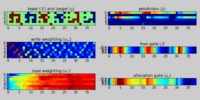CIFAR-10
The CIFAR-10 dataset (Canadian Institute For Advanced Research) is a collection of images that are commonly used to train machine learning and computer vision algorithms. It is one of the most widely used datasets for machine learning research.[1][2] The CIFAR-10 dataset contains 60,000 32x32 color images in 10 different classes.[3] The 10 different classes represent airplanes, cars, birds, cats, deer, dogs, frogs, horses, ships, and trucks. There are 6,000 images of each class.[4]
Computer algorithms for recognizing objects in photos often learn by example. CIFAR-10 is a set of images that can be used to teach a computer how to recognize objects. Since the images in CIFAR-10 are low-resolution (32x32), this dataset can allow researchers to quickly try different algorithms to see what works.
CIFAR-10 is a labeled subset of the 80 million tiny images dataset. When the dataset was created, students were paid to label all of the images.[5]
Various kinds of convolutional neural networks tend to be the best at recognizing the images in CIFAR-10.
Research papers claiming state-of-the-art results on CIFAR-10
This is a table of some of the research papers that claim to have achieved state-of-the-art results on the CIFAR-10 dataset. Not all papers are standardized on the same pre-processing techniques, like image flipping or image shifting. For that reason, it is possible that one paper's claim of state-of-the-art could have a higher error rate than an older state-of-the-art claim but still be valid.
| Paper title | Error rate (%) | Publication date |
|---|---|---|
| Convolutional Deep Belief Networks on CIFAR-10[6] | 21.1 | August, 2010 |
| Maxout Networks[7] | 9.38 | 2013-02-13 |
| Wide Residual Networks[8] | 4.0 | 2016-05-23 |
| Neural Architecture Search with Reinforcement Learning[9] | 3.65 | 2016-11-04 |
| Fractional Max-Pooling[10] | 3.47 | 2014-12-18 |
| Densely Connected Convolutional Networks[11] | 3.46 | 2016-08-24 |
| Shake-Shake regularization[12] | 2.86 | 2017-05-21 |
| Coupled Ensembles of Neural Networks[13] | 2.68 | 2017-09-18 |
| ShakeDrop regularization[14] | 2.67 | Feb 7, 2018 |
| Improved Regularization of Convolutional Neural Networks with Cutout[15] | 2.56 | Aug 15, 2017 |
| Regularized Evolution for Image Classifier Architecture Search[16] | 2.13 | Feb 6, 2018 |
| Rethinking Recurrent Neural Networks and other Improvements for Image Classification[17] | 1.64 | July 31, 2020 |
| AutoAugment: Learning Augmentation Policies from Data[18] | 1.48 | May 24, 2018 |
| A Survey on Neural Architecture Search[19] | 1.33 | May 4, 2019 |
| GPipe: Efficient Training of Giant Neural Networks using Pipeline Parallelism[20] | 1.00 | Nov 16, 2018 |
See also
References
- ↑ "AI Progress Measurement". Electronic Frontier Foundation. 2017-06-12. https://www.eff.org/ai/metrics.
- ↑ "Popular Datasets Over Time | Kaggle". https://www.kaggle.com/benhamner/popular-datasets-over-time/code.
- ↑ Hope, Tom; Resheff, Yehezkel S.; Lieder, Itay (2017-08-09). Learning TensorFlow: A Guide to Building Deep Learning Systems. O'Reilly Media, Inc.. pp. 64–. ISBN 9781491978481. https://books.google.com/books?id=sUowDwAAQBAJ&pg=PA64. Retrieved 22 January 2018.
- ↑ Angelov, Plamen; Gegov, Alexander; Jayne, Chrisina; Shen, Qiang (2016-09-06). Advances in Computational Intelligence Systems: Contributions Presented at the 16th UK Workshop on Computational Intelligence, September 7–9, 2016, Lancaster, UK. Springer International Publishing. pp. 441–. ISBN 9783319465623. https://books.google.com/books?id=jnD_DAAAQBAJ&pg=PA441. Retrieved 22 January 2018.
- ↑ Krizhevsky, Alex (2009). "Learning Multiple Layers of Features from Tiny Images". https://www.cs.toronto.edu/~kriz/learning-features-2009-TR.pdf.
- ↑ "Convolutional Deep Belief Networks on CIFAR-10". https://www.cs.toronto.edu/~kriz/conv-cifar10-aug2010.pdf.
- ↑ Goodfellow, Ian J.; Warde-Farley, David; Mirza, Mehdi; Courville, Aaron; Bengio, Yoshua (2013-02-13). "Maxout Networks". arXiv:1302.4389 [stat.ML].
- ↑ Zagoruyko, Sergey; Komodakis, Nikos (2016-05-23). "Wide Residual Networks". arXiv:1605.07146 [cs.CV].
- ↑ Zoph, Barret; Le, Quoc V. (2016-11-04). "Neural Architecture Search with Reinforcement Learning". arXiv:1611.01578 [cs.LG].
- ↑ Graham, Benjamin (2014-12-18). "Fractional Max-Pooling". arXiv:1412.6071 [cs.CV].
- ↑ Huang, Gao; Liu, Zhuang; Weinberger, Kilian Q.; van der Maaten, Laurens (2016-08-24). "Densely Connected Convolutional Networks". arXiv:1608.06993 [cs.CV].
- ↑ Gastaldi, Xavier (2017-05-21). "Shake-Shake regularization". arXiv:1705.07485 [cs.LG].
- ↑ Dutt, Anuvabh (2017-09-18). "Coupled Ensembles of Neural Networks". arXiv:1709.06053 [cs.CV].
- ↑ Yamada, Yoshihiro; Iwamura, Masakazu; Kise, Koichi (2018-02-07). "Shakedrop Regularization for Deep Residual Learning". IEEE Access 7: 186126–186136. doi:10.1109/ACCESS.2019.2960566.
- ↑ Terrance, DeVries; W., Taylor, Graham (2017-08-15). "Improved Regularization of Convolutional Neural Networks with Cutout". arXiv:1708.04552 [cs.CV].
- ↑ Real, Esteban; Aggarwal, Alok; Huang, Yanping; Le, Quoc V. (2018-02-05). "Regularized Evolution for Image Classifier Architecture Search with Cutout". arXiv:1802.01548 [cs.NE].
- ↑ Nguyen, Huu P.; Ribeiro, Bernardete (2020-07-31). "Rethinking Recurrent Neural Networks and other Improvements for Image Classification". arXiv:2007.15161 [cs.CV].
- ↑ Cubuk, Ekin D.; Zoph, Barret; Mane, Dandelion; Vasudevan, Vijay; Le, Quoc V. (2018-05-24). "AutoAugment: Learning Augmentation Policies from Data". arXiv:1805.09501 [cs.CV].
- ↑ Wistuba, Martin; Rawat, Ambrish; Pedapati, Tejaswini (2019-05-04). "A Survey on Neural Architecture Search". arXiv:1905.01392 [cs.LG].
- ↑ Huang, Yanping; Cheng, Yonglong; Chen, Dehao; Lee, HyoukJoong; Ngiam, Jiquan; Le, Quoc V.; Zhifeng, Zhifeng (2018-11-16). "GPipe: Efficient Training of Giant Neural Networks using Pipeline Parallelism". arXiv:1811.06965 [cs.CV].
External links
- CIFAR-10 page - The home of the dataset
- Canadian Institute For Advanced Research
Similar datasets
- CIFAR-100: Similar to CIFAR-10 but with 100 classes and 600 images each.
- ImageNet (ILSVRC): 1 million color images of 1000 classes. Imagenet images are higher resolution, averaging 469x387 resolution.
- Street View House Numbers (SVHN): Approximately 600,000 images of 10 classes (digits 0-9). Also 32x32 color images.
- 80 million tiny images dataset: CIFAR-10 is a labeled subset of this dataset.


